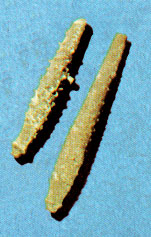



Ancient Life in Kansas Rocks, part 20 of 27
The elongate objects in the center of this photograph (slightly enlarged) are echinoid spines. Sea urchins are living echinoids with similar spines. Echinoids, whose name is derived from the Latin word for prickle, are generally globular, discoidal, or heart-shaped animals having a box-like skeleton composed of many plates enclosing the vital organs. they are covered with movable spines which give protection and provide locomotion.

At the lowest extremity of the spines a narrow base may be seen that is concave and fits onto a ball-like structure on the skeletal plate. Thus, there is a socket-and-ball relationship between the spine and plate. The ring or flange just above the base of the spine provides an area to which muscles attach; it is the flexing of these muscles that move the spines that in turn propel the echinoid across the sea bottom. These spines are common fossil fragments. (Topeka Limestone, Upper Pennsylvanian)
Kansas Geological Survey
Placed online Feb. 1997
URL = "http://www.kgs.ku.edu/Publications/ancient/f20_echin.html"
Send comments and/or suggestions to webadmin@kgs.ku.edu